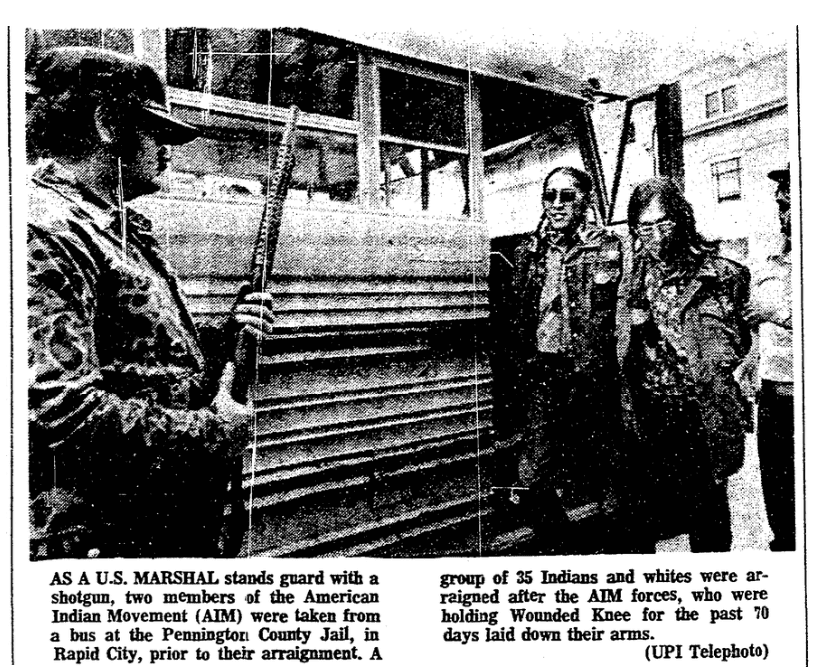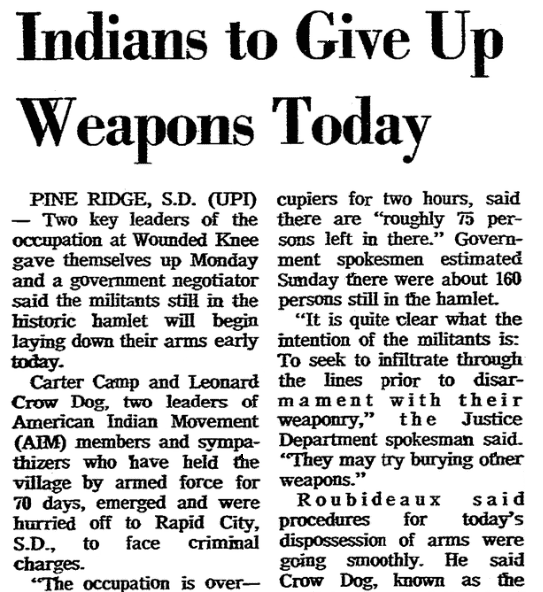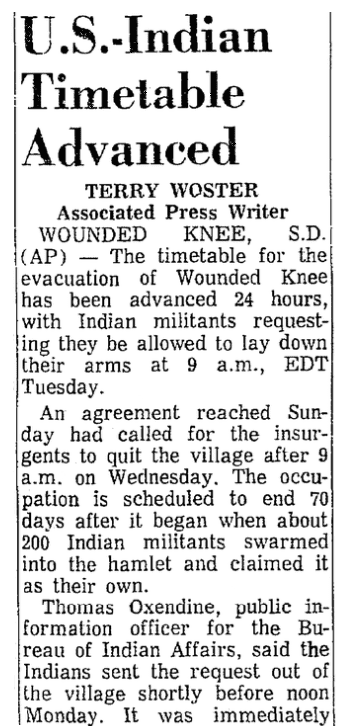Traditional members of the Oglala Lakota (Sioux) tribe on the Pine Ridge Indian Reservation in South Dakota were fed up in early 1973. Living conditions on the reservation were terrible, and the local government – the tribal council – was dominated by Richard Wilson, a man the traditionalists considered harsh and corrupt.
When an attempt to impeach Wilson failed, the traditionalists turned to a more drastic form of action. On 27 February 1973, with the aid of activists from the American Indian Movement (AIM), more than 200 protesters occupied the town of Wounded Knee, South Dakota. The occupation lasted 71 days, not ending until 8 May 1973.

The site of their protest was a symbolic choice: Wounded Knee was where U.S. troops had massacred anywhere from 150 to 300 peaceful Lakota in 1890. The protesters hoped the U.S. government would not dare stage a second massacre at such an infamous place. With influence from the AIM leaders, the Wounded Knee occupiers enlarged the scope of their protest to not only improving conditions on the reservation – they called upon the federal government to redress wrongs inflicted on Native Americans by centuries of broken treaty promises.
The government response was to cordon off Wounded Knee with a large force of U.S. marshals, FBI agents, and other law enforcement officers, using armored personnel carriers, machine guns and other heavy weaponry, and helicopters. For 70 tense days the standoff continued, with numerous exchanges of gunfire between the opposing sides, but little progress in the way of negotiation or settlement.
During the course of the siege two Indians were killed in the gunfire exchanges and several wounded. One U.S. marshal was paralyzed by a gunshot; he later died from complications related to his shooting. Finally, on the morning of the 71st day of the occupation, the occupiers laid down their guns and surrendered. Media coverage – which initially was extensive but had waned as the occupation dragged on – returned to cover the surrender.
The occupation was over – the siege was lifted – but very little had changed. Government promises to investigate the traditionalists’ complaints went unfulfilled. The next year Richard Wilson was again elected head of the tribal council despite allegations of voter fraud, and dozens of traditionalists were killed under mysterious conditions. Two AIM leaders, Dennis Banks and Russell Means, were indicted for crimes connected to the occupation, but the case against them was dismissed due to prosecutorial misconduct. An appeals court upheld the decision to dismiss the case.
The following two newspaper articles, one furnished by United Press International and the other by Associated Press, tell the story of the surrender. These two articles were printed in newspapers across the country.

Here is a transcription of this article:
Indians to Give Up Weapons Today
PINE RIDGE, S.D. (UPI) – Two key leaders of the occupation at Wounded Knee gave themselves up Monday [yesterday] and a government negotiator said the militants still in the historic hamlet will begin laying down their arms early today.
Carter Camp and Leonard Crow Dog, two leaders of American Indian Movement (AIM) members and sympathizers who have held the village by armed force for 70 days, emerged and were hurried off to Rapid City, S.D., to face criminal charges.
“The occupation is over – no doubt about it,” said Ramon Roubideaux, AIM chief counsel.
24 Hours Early
Richard Hellstern, deputy assistant attorney general, announced that the militants still holed up in Wounded Knee have agreed to begin surrendering their weapons at 7 a.m. today, advancing the surrender by 24 hours.
Hellstern said the stepped-up schedule was suggested by Crow Dog and Dennis Banks, another militant leader, who was believed still in Wounded Knee.
The Justice Department spokesman said he believed the surrender of arms and a sweep of the village by U.S. marshals could be completed today.
Thirteen of the militants, carrying “substantial weaponry,” were arrested during the night. At least 10 women were known to have come out of the hamlet Monday, and Roubideaux, who conferred with the occupiers for two hours, said there are “roughly 75 persons left in there.” Government spokesmen estimated Sunday there were about 160 persons still in the hamlet.
“It is quite clear what the intention of the militants is: To seek to infiltrate through the lines prior to disarmament with their weaponry,” the Justice Department spokesman said. “They may try burying other weapons.”
Roubideaux said procedures for today’s dispossession of arms were going smoothly. He said Crow Dog, known as the medicine man and “spiritual leader” of the militants, might be asked to return to Wounded Knee today to lead the remaining Indians and white militants out.

Here is a transcription of this article:
U.S.-Indian Timetable Advanced
Terry Woster
Associated Press Writer
WOUNDED KNEE, S.D. (AP) – The timetable for the evacuation of Wounded Knee has been advanced 24 hours, with Indian militants requesting they be allowed to lay down their arms at 9 a.m., EDT Tuesday [today].
An agreement reached Sunday had called for the insurgents to quit the village after 9 a.m. on Wednesday. The occupation is scheduled to end 70 days after it began when about 200 Indian militants swarmed into the hamlet and claimed it as their own.
Thomas Oxendine, public information officer for the Bureau of Indian Affairs, said the Indians sent the request out of the village shortly before noon Monday. It was immediately accepted, he said.
Ramon Roubideaux, an attorney for the American Indian Movement, spent several hours in the village Monday and said afterward, “Everything is working beautifully. The occupation is ended.”
Earlier, another government spokesman had expressed disappointment with a list of weapons and personnel turned over Sunday evening by Indian leaders. The list was the first phase of the disarmament agreement. It was to be used as a check against the arms turned in at the teepee chapel when the disarmament takes effect.
Deputy Asst. U.S. Atty. Gen. Richard Hellstern told a news briefing the list included only a small-bore pistol and a peace pipe. He said personnel listed included two persons known to be under federal indictment, 23 permanent village residents and 13 persons who were neither residents nor among those indicted.
Hellstern said, “We certainly know there have been more weapons in the village than are on the list.” He said the small-bore pistol could not have accounted for a 100-shot salute Sunday afternoon at the burial of Lawrence Lamonte, 31, a victim of the siege.
A CBS newsman who visited Wounded Knee late last week estimated about 150 Indians and 15 white persons were among the occupation force.
AIM leaders Carter Camp and Leonard Crow Dog surrendered to federal authorities at a roadblock late Monday. They were immediately taken to Rapid City for bond hearings.
Hellstern said the government tightened its cordon of Wounded Knee Sunday night in anticipation that some of the occupants might try to escape. By late Monday, about 20 persons had been arrested – some who were trying to sneak out, others who surrendered at roadblocks.
“It was clear what the intention was. The warrior types with warrants outstanding would attempt to infiltrate the perimeter and leave,” Hellstern added. He said federal reinforcements tightened the seal to prevent escapes.
He said those arrested were carrying “substantial weaponry, including ammunition, one gun akin to a submachine gun and several carbines and .22-caliber rifles. They made no attempt to confront the marshals, and the only shot fired during the night was a warning shot by a marshal at a bunker.”
Note: An online collection of newspapers, such as GenealogyBank’s Historical Newspaper Archives, is not only a great way to learn about the lives of your ancestors – the old newspaper articles also help you understand American history and the times your ancestors lived in, and the news they talked about and read in their local papers – as well as more recent events.
Related Articles:
